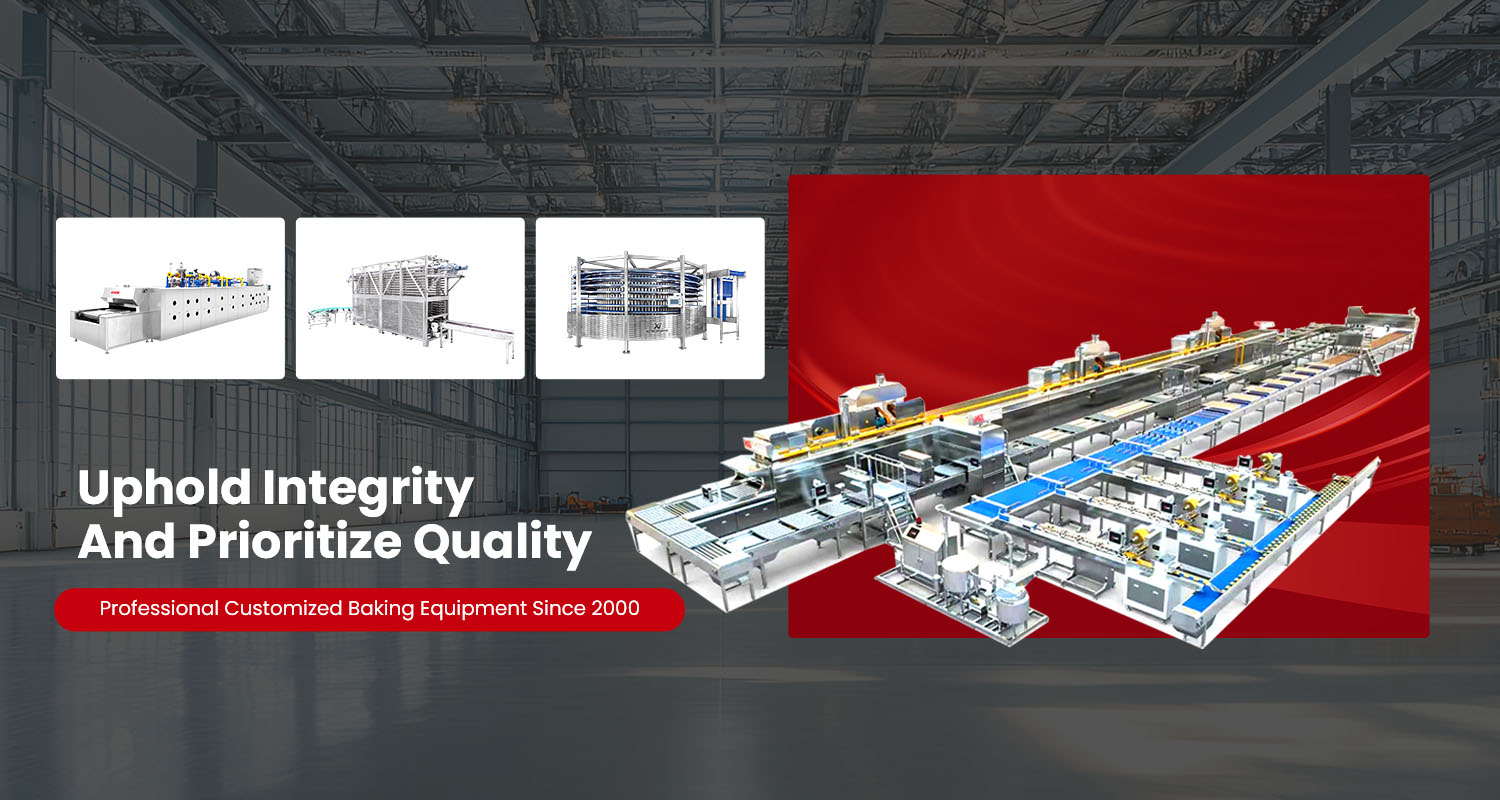Fully Automated Croissant Production Line Process
The fully automated croissant production line is designed to achieve high efficiency and consistent quality in croissant production. With a production capacity of 5 tons per day, this line integrates advanced technologies and automation to ensure every croissant meets the highest standards.

1. Automated Raw Material Feeding System
Equipment
Pneumatic conveyor
Automated weighing and dispensing system
Process
Dry Ingredients: Flour, sugar, and salt are transported via a vacuum pipeline directly to the mixer. This ensures precise and consistent delivery of dry ingredients.
Liquid Ingredients: Milk, water, and eggs are injected into the mixer through precision metering pumps, guaranteeing accurate quantities.
Yeast: Yeast is added separately to avoid direct contact with salt, which can inhibit yeast activity.
2. Dough Preparation
Equipment
Spiral mixer with temperature control
Parameters
Mixing: The mixer operates at low speed for 8 minutes, followed by high speed for 2 minutes. The dough temperature is carefully controlled to remain at or below 22°C.
Discharge and Relaxation: The dough is automatically discharged into a holding tank where it undergoes chilled relaxation at 5°C for 30 minutes. This step allows the gluten to relax, making the dough more manageable for subsequent processes.
3. Automated Lamination & Folding
Equipment
Continuous sheeter
Automatic butter sheet feeder
Process
Rolling and Butter Layering: The dough is rolled to a thickness of 5mm using multi-stage rollers. A robotic arm then layers butter sheets, each 0.5cm thick, onto the dough.
Lamination: The dough undergoes an automated 3-fold lamination process. After each fold, the dough is chilled at -4°C for 20 minutes. This step is crucial for achieving the flaky layers characteristic of croissants.
4. Forming Section
Equipment
CNC cutting & rolling machine
Steps
Sheeting and Cutting: The dough is sheeted to a thickness of 3mm. Laser-guided cutting ensures precise isosceles triangles are cut, with a base length of 12cm ± 0.2mm.
Rolling: A robotic arm rolls the triangles into croissant shapes, sealing the ends with pressure. The rolling speed is adjustable to ensure uniformity.
Conveying: The formed croissants are conveyed to the proofing line.
5. Automated Proofing System
Equipment
Spiral fermentation tank
Fermentation room with closed-loop humidity/temperature control
Parameters
Proofing Conditions: The croissants are proofed at a temperature of 28°C ± 0.5°C and a relative humidity (RH) of 78% ± 2%. The proofing time is set at 2.5 hours.
CO₂ Monitoring: The system continuously monitors CO₂ levels and adjusts ventilation automatically to maintain optimal conditions.
6. Baking & Demolding
Equipment
gas-fired tunnel oven with steam injection
Process
Baking Zones:
Preheat Zone: 180°C for 2 minutes
Setting Zone: 200°C for 5 minutes
Coloring Zone: 190°C for 3 minutes
Post-Baking Transfer: The baked croissants are transferred via a heat-resistant silicone conveyor, which prevents sticking and ensures the croissants maintain their shape.
7. Cooling & Quality Inspection
Equipment
Spiral Cooling Tower with forced-air cooling
Standards
Cooling: The croissants are cooled to a core temperature of ≤25°C within 25 minutes.
Quality Inspection: An AI vision system inspects the croissants, rejecting any cracked or deformed products with an accuracy rate of ≥99%.
8. Automated Packaging
Equipment
Multi-head weigher
Flow-wrap machine
Process
Bagging: The croissants are automatically bagged, with 1-2 pieces per bag and a tolerance of ±1g.
Nitrogen Flushing: The bags are flushed with nitrogen to ensure an oxygen residual of ≤1%, preserving freshness.
Sealing and Coding: The bags are heat-sealed, and laser date coding is applied with a precision of 0.1mm.
9. Palletizing & Warehousing
Equipment
Robotic palletizer
AGV (Automated Guided Vehicle) transport
Process
Palletizing: The packaged croissants are palletized by a robotic palletizer, ensuring efficient and accurate stacking.
Transport: AGVs transport the pallets to the warehouse for storage and distribution.
Conclusion
The fully automated croissant production line leverages cutting-edge technology to streamline the production process, ensuring high efficiency, consistency, and quality. From raw material feeding to final packaging, each step is meticulously controlled to produce perfect croissants every time.






